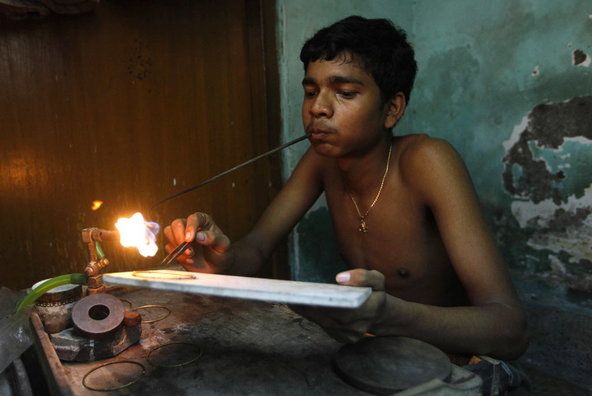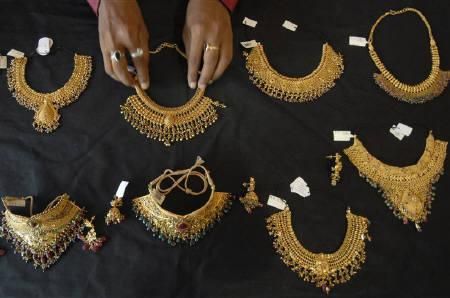 | « Back to article | Print this article |
Zaveri Bazaar is probably the oldest gold market in India and yet there are many areas that are still untouched by the development.
The quaint old jewellery shops and dilapidated buildings still maintain an old world charm. With over 7,000 shops in the midst of old temples, some dating back to over 200 years, it is easy to see why Zaveri Bazaar continues to maintain its heritage, Shaheen Mansuri/Rediff.com reports.

Nestled between Crawford Market and Mumbadevi, the 150-year old Zaveri Bazaar (jewellery market) in south Mumbai is literally a feast for the eyes.
The market controls over 60 per cent of India’s gold trade and has over 7,000 shops selling traditional and contemporary gold, platinum and diamond jewellery.
Many of them occupy less 150-sq feet of shop space - but are easily worth crores of rupees.
The uniqueness of this market is that it still retains the old world charm with most of the shops still retaining antique furniture and old staff.
Despite having old-fashioned shops, the jewellers are very much aware with what's happening around them.

One of the jewellers, Bhikaji Uttamchand says that the Indian Bullion and Jewellers Association (IBJA) with whom of most of the goldsmiths are registered with, have appealed to the government to give them permission to launch a gold monetisation scheme.
"Around 25,000 tonne of gold is lying idle in households across the country. If a scheme wherein a depositor gets decent interest on the gold deposited with jewellers and banks for a certain period would not only bring idle gold into the system but would also reduce our dependence on imports," he said.
Another jeweller points out that there are talks the government may launch gold amnesty scheme to tap undeclared gold in the country.
If the scheme is launched, holders will be encouraged to declare their gold and in turn, the government can issue 10-year zero coupon bonds to them.

The yield on these bonds can be around 4 per cent and on redemption the amount that is paid will not be taxed in the hands of the holder-- a winful situation for the government and the gold holder, he adds.
Meanwhile, visit Zaveri Bazaar anytime of the day and you will find the streets packed with pedestrians, visitors and businessmen alike.
Very old and dilapidated buildings which house residential and commercial units where jewellery is processed do not go unnoticed.
There are at least 30,000 karigars (artisans), mostly from West Bengal working in gold refining, processing and designing units and its not an exaggeration to say that they work and live in extremely hazardous conditions - a thing of great concern.

In fact quite a few goldsmiths have converted a portion of their residences in the adjoining Kalbadevi and Bhuleshwar area into workshops where these artisans use toxic substance to polish, refine and melt gold.
The presence of noisy and heavy machines used for giving jewellery the desired shape is an irritant the local resident have to endure.
The tussle between the resident association and the shopkeepers is on since the past few years.
Recently, city traffic police commissioner, Milind Bharambe as marked Zaveri Bazaar and Crawford Market as no hawking and no parking zone. It is a wait-and-watch situation if the traffic congestion will ease or not as there are roughly around 500,000 visitors in the area on a daily basis.

Mohit Kamboj, president of the India Bullion And Jewellers Association tells Rediff.com, “We have proposed to Maharashtra Chief Minister Devendra Fadnavis to shift the market to a sprawling 500-acre land at Panvel where we want to create a knowledge park for training the artisans along with jewellery shops on the adjoining plot.”
However, few goldsmiths with whom Rediff.com spoke to seem to be uninterested in shifting to Panvel which is 60 kms away from Mumbai.

Despite few odds, Zaveri Bazaar (a few old timers also call it (Daagina Bazaar) has a distinct flavour.
From shops which are as old as the 300-year old Narangdas Mandardas to Tribhovandas Bhimji Zaveri which was established in 1864, there are other old shops which also sell second hand gold, platinum and silver jewellery.
Interestingly, if one were to visit a particular jewellery shop for the second time, there is a strong possibility that you may forget the way despite having the address with you. It’s highly recommended that you remember the number of the shop.
Despite being thickly populated, you will never miss out extraordinary landmarks in the vicinity of Zaveri Bazaar.

Take for instance, the Dharam Kaanta which was created around 70-80 years ago to protect the interest of retail buyers.
Dharam Kaanta is a typical old-fashioned shop where a gold smith sits on a gaddi and his staff checks the purity of jewellery, which is not hallmarked, for a nominal fee of Rs 150-200.
During Dhanteras and Akshay Thrithya the Dharam Kaanta is packed with customers.
The gold purity certificate issued by them is the final word for any jeweller in the country.

A staff explains that apart from the Dharam Kaanta, there are quite a few gold 'refineries' at the outskirts of Mumbai where imported gold in the form of dore bars are sent for refining process.
Dore bars weigh around 25 kg and have other metals present in it to the extent of 0.5 per cent which is refined and fabricated up to 999.9 purity at these 'refineries' which is then ready for retail market.
Few interesting facts Jain shares about why despite higher price and volatile currency, business is as usual at the iconic Zaveri Bazaar.
*Gold demand is ever increasing in India as Indians have some kind of an emotional bond with the precious yellow metal.
*Gold is regarded as a safe investment, especially in rural India where masses do not have alternate investment options.

*Around 75 per cent of gold demand is in the form of household consumption, most coming from South and western parts of the country, where gold is regarded sacred.
*In FY14 when the Indian rupee weakened against the dollar, the government and the Reserve Bank of India tightened norms to curb imports which led to a huge impact as market turnover dropped 21 per cent. However, in year-to-date period, imports have picked up despite weakening of the rupee, which hardly had any impact on gold consumption.
*In the long term due to the rising middle-class population, gold demand in India will continue to rise at least 10 per cent and will support long-term gold prices.
Images are for representation purpose only.